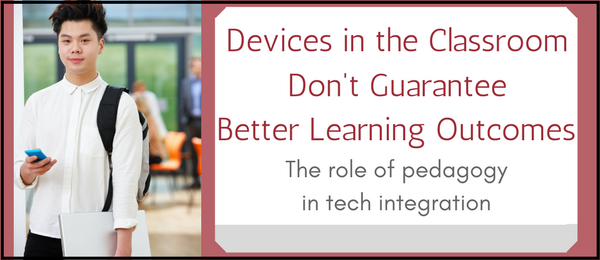Tech Integration is More Than Device Use
In an article addressing the topic of tech integration for the Classroom section of EdTech Magazine (online) called “Why Pedagogy First, Tech Second Stance is Key to the Future,” author Eric Sheninger voices some valid concerns about the direction of device-enabled ed-tech that are most likely echoed by many educators today.
Attempting to be current, modern, and up-to-speed with technological trends and initiatives, many districts get caught up in the race to acquire technology and infrastructure without well-developed plans for successful implementation or how the technology will support learning outcomes. Sheninger warns,
While I am a huge advocate for the purposeful integration of technology in schools, we must resist the temptation to think that this is the solution to solve all the ills in our current education system.*
He points out that today’s students, already familiar with technology, are not any more likely to learn just because they’re handed a device in a learning environment.
Devices As a Complement to Learning, Not Drivers of Instruction
When we care most about the success of the students, we realize that devices are not meant to control the direction of education, but rather improve the experience. Sheninger states,
When implementing and successfully sustaining a mobile learning initiative, it is imperative not to allow the device to drive instruction. Lessons, curriculum, schools and districts should never be built around technology. Everything we do in education should be built around learning. Thus, if the ultimate goal is to improve student outcomes then the role of any mobile device initiative should be to support or enhance learning.*
Mastery is More Important Than Ever
The troubling trend of purchasing technology just to have it is a disservice to students, wasting time and resources that could be dedicated to planning valuable instruction. Along those lines, it could be said that handing a student a device without a solid plan is more of a distraction than a support. Sheninger’s opinion is that having a strong pedagogical foundation in place, with better assessments aligned to standards, is key to any successful technology integration initiative.
Furthermore, the presence of devices in the classroom places even more emphasis on learners’ ability to demonstrate mastery of a concept; the device is just an additional card in the deck of student choice and ownership. If proper plans are in place for supporting learning outcomes with tech, it should be easier to prove mastery in 1:1 and BYOD environments where devices serve as utilities to motivate, inspire, and enhance learning. The first step is always to ask how the tools in question will support learning while adding relevance for the student.
Tech Integration and Pedagogy: The TPACK Model
In reference to the TPACK (Technological Pedagogical Content Knowledge) framework for tech integration, which differentiates between use of technology versus integration of technology, authors Bobby Hobgood and Lauren Ormsby share their opinions and findings in an article titled “Inclusion in the 21st-century classroom: Differentiating with technology,” on the LearnNC.org website. According to them,
The first and most important principle of technology integration is that the focus should be on the outcome of the instruction, and not on the technology itself. When technology is used just for the sake of doing something new and different, teachers fail to harness the affordances of the technology to support the needs of the learning situation.***
They go on to say that “Skillful integration of any piece of technology demands a more intentional approach to its instructional use.” Citing Judi Harris and Mark J. Hofer, authors of the article “Grounded Tech Integration: An Effective Approach Based on Content, Pedagogy, and Teacher Planning“ from the College of William and Mary, they share the “five basic instructional decisions” that should “form the basis of planning a learning event. They are, in order:
- Choosing learning goals
- Making practical pedagogical decisions about the nature of the learning experience
- Selecting and sequencing activity types to combine to form the learning experience
- Selecting formative and summative assessment strategies that will reveal what and how well students are learning
- Selecting tools and resources that will best help students to benefit from the learning experience being planned”***
Hobgood and Ormsby conclude, “This framework emphasizes that the selection of tools and resources should follow naturally from the other instructional planning decisions. Following this model increases the likelihood of seamless, successful technology integration that meets the needs of all learners.”**
Devices in the Classrom: Digital Do-Gooders or Just Distractions?
Echoing this philosophy as indicated by the title of his article, Eric Sheninger advocates a “pedagogy first, tech second” perspective when it comes to device initiatives in schools. With the acknowledgement that devices and technology can aid in the development of essential skills, it remains important to emphasize that assessment and feedback are still essential components of instruction. Sheninger closes out the article with this strong statement:
Mobile learning represents a huge investment in time, money, and other resources. With so much at stake the goal should be placing a powerful learning tool in the hands of our students — not a digital pacifier.*
Join the conversation! What’s your philosophy on tech in the classroom? How have tech integration initiatives improved your instruction, and what challenges have they presented? If you’re looking for ways to increase your understanding and gain ideas for more meaningful tech integration, consider joining us for the following valuable courses, available as Eduspire professional development courses or as Wilson College graduate-level courses:
— Effective Formative Assessment and Technology
— Tech Integration
Sources:
-
*Why Pedagogy First, Tech Second Stance is Key to the Future
— Eric Sheninger, EdTechMagazine.com -
**Inclusion in the 21st-century classroom: Differentiating with technology
— Bobby Hobgood, Ed.D. and Lauren Ormsby, LearnNC.org -
***Grounded Tech Integration: An Effective Approach Based on Content, Pedagogy, and Teacher Planning
— Judi Harris and Mark J. Hofer, College of William and Mary


Pingback:Technology…Good For the Classroom Or Bad? – From Teacher to Teacher